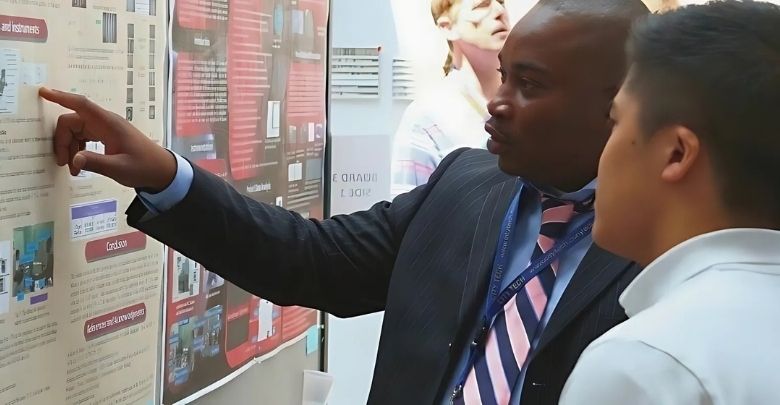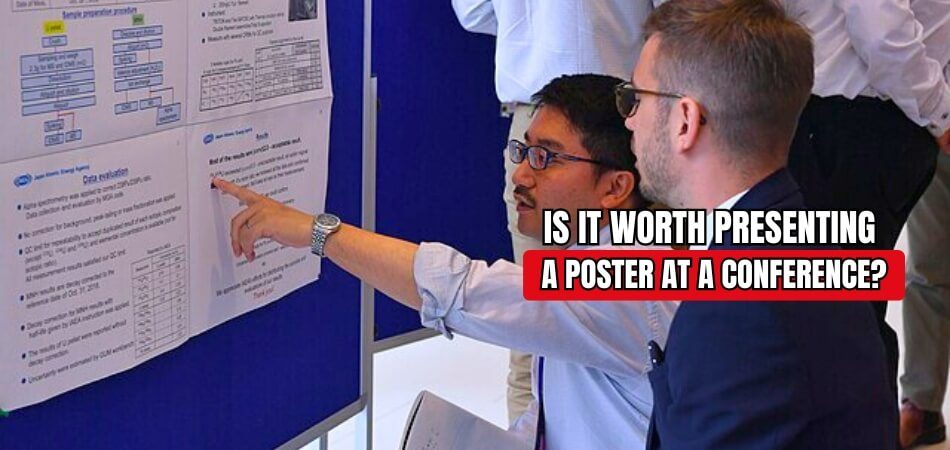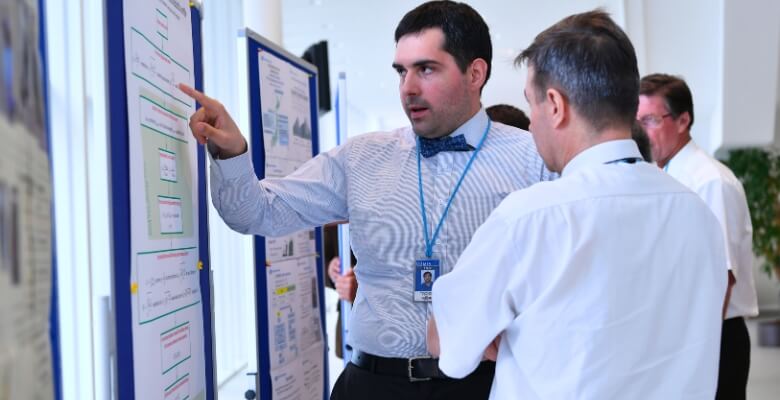A great way to share your research with a wide range of people is to present a poster at a conference. It allows you to visually display your work and engage with attendees through meaningful conversations. However, many might wonder, “Is it worth presenting a poster at a conference?” This question is essential as it helps researchers evaluate their participation.
The value of presenting a poster at a conference lies in the opportunity to connect with other professionals, showcase your findings, and receive helpful feedback. Engaging in discussions about your research can lead to collaborations, enhance your visibility in your field, and improve your public speaking skills. Thus, it is an enriching experience for both emerging and established researchers.
Are you curious about the various aspects of poster presentations? This article will delve deeper into the benefits, preparation tips, and common pitfalls to avoid. You’ll find all the essential information to make the most of your conference experience.
What is a Conference Poster Presentation?
The purpose of a conference poster presentation is to present research visually and concisely. Posters feature key points and findings, often displayed on a large board. Conference attendees can view these posters, and the presenters explain their work. It encourages focused interactions about the research presented.
In preparing a poster, presenters arrange their data and findings into sections that are easy to understand. This layout often includes background information, methods, results, and discussions. Colorful graphics, images, and charts are commonly used to make the poster visually engaging. The layout helps viewers get the main ideas quickly.
Presenters usually stand near their posters to discuss their work with attendees. This setup allows people to ask questions and understand the details better. Presenters may answer specific questions about their research methods or findings. This setup makes the presentation interactive and adds value to the conference experience.
During a conference, presenting a poster at a conference gives attendees the chance to connect with the researcher. This approach allows others to engage more directly with the project. Presenters can explain unique aspects that may not be clear on the poster alone. This allows for detailed feedback on their research.
Is It Worth Presenting a Poster at a Conference?
There are innumerable opportunities to network, communicate, and influence your field by presenting a poster at a conference. By showcasing your research or insights visually, you can inspire, educate, and foster discussions that lead to future opportunities and collaborations. Here’s what to consider to make the most of this experience:
Networking and Building Professional Connections
Engaging with conference attendees gives you access to a wealth of professional connections. Poster presentations offer a unique chance to directly meet professionals who share your interests. By explaining your ideas in person, you build rapport, opening doors to future collaborations or job opportunities.
Improve Your Public Speaking Skills
Conference presentations are an excellent setting to improve public speaking skills in a welcoming environment. Delivering your ideas repeatedly to various audiences boosts your confidence. With each conversation, you fine-tune how to communicate your message effectively, which can strengthen your communication abilities long-term.
Receiving Helpful Feedback
Feedback from peers and experts at a conference can be invaluable. Attendees often offer insights or alternative viewpoints, helping you refine your work. Hearing constructive criticism in real-time allows you to identify strengths and areas for improvement, pushing your research to the next level.
Increasing Your Research Visibility
A poster session increases the visibility of your work, reaching a wider and more diverse audience. Attendees can quickly grasp the core of your research, which increases its impact. Even if you don’t engage with everyone, the visual presence of your poster still spreads your work effectively.
Developing Professional Confidence
Presenting in front of professionals can significantly boost your self-confidence. Each interaction strengthens your poise and self-assurance.
As you present your work, you become more comfortable sharing your ideas, which is an essential skill for advancing in any career.
Creating Publication and Collaboration Opportunities
Conferences often attract experts seeking collaboration, and your poster can spark interest. When others find value in your work, it may lead to co-authored publications or joint projects. These opportunities can enhance your reputation and expand your research reach significantly.
Gaining Recognition and Visibility in Your Field
Presenting your poster establishes you as a credible contributor to your field. Gaining visibility at reputable conferences builds your professional reputation. This recognition can positively influence your career trajectory, opening doors to future opportunities and strengthening your standing in the academic community.
Participating in a conference and presenting a poster offers many benefits for one’s career. By engaging in this unique forum, you build skills, connections, and visibility, each of which improves your career in valuable ways.
What Are the Key Components of a Well-Designed Conference Poster?
A well-designed conference poster draws attention, communicates complex ideas clearly, and encourages engaging discussions. Preparing a poster with organized sections, striking visuals, and concise information will leave a lasting impression. Here’s how to create one effectively:
- Title and Author Information: Place a concise and engaging title at the top, including author names and affiliations. This provides essential details, helping viewers recognize the research topic and contributors.
- Clear Structure and Flow: Arrange the poster sections logically, guiding viewers through the research. Use a left-to-right or top-to-bottom layout so information flows naturally and remains easy to follow.
- Concise Text and Key Points: Prioritize brief, informative text to convey only the core ideas. Using bullet points, instead of paragraphs, allows viewers to scan quickly and grasp essential concepts without extra reading.
- Engaging Visuals and Graphics: Include charts, diagrams, or images that summarize findings effectively. These visuals attract attention and provide clear data points, helping people understand complex information at a glance.
- Consistent Font and Color Scheme: Choose legible fonts and a consistent color scheme that aligns with your topic. Avoid overly bright colors, and ensure the font size is readable from a reasonable distance.
- Prominent Findings and Discussion: Highlight significant findings and insights in a dedicated section. This summary of results allows viewers to understand your research’s impact without needing to read extensive details.
- QR Codes or Contact Information: Add QR codes linking to additional resources, like a full paper or presentation slides. This encourages further exploration of your work and provides a convenient way for others to follow up.
An effective conference poster balances clarity, visual appeal, and concise content. Designing with the audience in mind encourages interest and meaningful engagement with your research. Aim to leave a memorable impression that invites further discussion and exploration.
How to Prepare an Effective Poster Presentation for a Conference?
A successful conference poster relies on smart design choices, clear organization, and strong visual elements. Incorporating a blend of creativity and structure can make your poster not only informative but also memorable. Consider these essential aspects to improve your poster’s impact.
Plan Visual Structure Carefully
Creating a visual structure ensures the main points are the most noticeable elements. This method directs the viewer’s eye to essential parts first, building a logical flow through the poster. Effective spacing and text emphasis, such as bold or italics, will guide readers effortlessly.
Utilize Consistent Design Elements
Choosing consistent colors, fonts, and shapes adds coherence across the poster. A harmonious design feels more professional, improving the overall appearance. Consistency in design helps bring your ideas together effectively and keeps distractions to a minimum. When using PowerPoint, for instance, you can explore some PowerPoint tips for conference posters to ensure a polished look.
Maintain a Clean and Balanced Layout
Balancing visuals and text keeps the poster clean and organized, avoiding overcrowding. Strategic use of white space between sections or elements creates a breathable layout. It helps viewers process information faster and supports a more visually appealing design overall.
Ensure Readability from a Distance
Large fonts for headings and sufficient spacing allow people to read without moving too close. Clear headings and simplified language maintain focus on key ideas. Including readable labels on any visuals further supports accessibility, keeping the audience engaged from various distances.
Use Quality Images and Graphics
High-resolution visuals, such as images and charts, provide clarity, allowing data and concepts to stand out. Avoid low-quality visuals that may appear blurry when printed or enlarged. Quality graphics convey professionalism, attracting interest and communicating your research’s relevance clearly.
Designing with an intentional approach brings clarity and appeal to your conference poster. Keeping it reader-friendly and visually engaging creates an inviting experience. This approach can make your work stand out and encourage more thoughtful interaction from viewers.
Common Mistakes to Avoid When Presenting a Poster at a Conference
Presenting a poster at a conference is a valuable experience that lets you showcase your work and engage with professionals. However, certain common mistakes can diminish the impact of your presentation, limiting its effectiveness. Here’s what to avoid to make your presentation as impactful as possible:
Overloading with Excessive Information
Including too much information on a poster can overwhelm viewers, making it hard for them to grasp your key points. Instead of dense text, highlight only the most relevant findings and insights. Keeping your poster concise encourages audience engagement and keeps their attention on your main ideas.
Being Unprepared to Engage with Viewers
Preparation is key to handling questions and facilitating discussions during your presentation. Arriving unprepared may result in missed opportunities to connect with attendees. Rehearsing your main points and possible answers to questions ensures you’ll engage confidently and improve your professional presence.
Lack of Clear and Focused Messaging
A poster that lacks a focused message can confuse viewers, leaving them unsure of your research’s significance. To avoid this, center your message around one or two main points, supporting them with clear visuals. This focus helps people understand your work quickly, increasing their interest.
Ignoring Visual Design and Layout
For your poster to be noticed and for viewers to remain engaged, visual design is essential. Crowded sections, mismatched fonts, or poor color choices can detract from your message. Investing the time required to create a conference poster with balanced visuals and clarity will help communicate your ideas more effectively.
Poor Use of Time During Presentation
Managing your time effectively during a poster session is vital to cover key points and allow for audience interaction. Talking too long on minor points or rushing through important sections can lose viewers’ interest. Practicing ahead of time can help you strike a balance and improve your overall presentation.
By recognizing and avoiding these common presentation mistakes, you can create a more compelling poster and ensure your time at the conference is well spent. Presenting effectively helps you build credibility and connect meaningfully with others in your field.
FAQs About Is It Worth Presenting a Poster at a Conference?
There are many opportunities to share research, interact with peers, and establish credibility when presenting a poster at a conference. If you’re considering this path, these FAQs address some common questions to help you understand the experience and its potential impact better.
How Can a Poster Presentation Impact My Career Development?
Presenting a poster improves your professional skills and strengthens your CV. This experience shows potential employers or collaborators that you can effectively communicate research findings and network with experts. Over time, these skills and the credibility earned can positively shape your career trajectory.
What Are Common Challenges When Presenting a Poster?
One common challenge is managing your time while interacting with multiple people. Engage meaningfully but briefly with each attendee. Another challenge is ensuring your poster remains visually clear and compelling amidst many other presentations, which requires thoughtful design.
Do I Need Prior Presentation Experience to Present a Poster?
You don’t need prior experience to present a poster successfully. Poster sessions offer a more relaxed environment than oral presentations, making them ideal for beginners. With some preparation, even first-time presenters can communicate their research confidently and make meaningful connections.
How Can I Attract More Attendees to My Poster?
Creating a visually appealing, well-organized poster helps capture attendees’ attention. Use concise text, bold graphics, and clear data points. Additionally, actively engaging with the audience by being approachable and inviting questions will encourage more people to visit your poster.
What Are Good Ways to Follow Up After a Conference?
Following up with attendees is vital to making the most of your poster presentation. Connect with people on professional networking platforms, send personalized emails, or share further resources. This follow-up helps solidify connections, opening doors to future collaborations and extending your research’s impact.
End Note
By presenting a poster at a conference, you can meet experts in your field, present your research, and get helpful criticism. This unique opportunity combines creativity with networking, making your work more visible and sparking insightful discussions with a diverse audience.
So, is it worth presenting a poster at a conference? Absolutely. The experience offers valuable rewards, from boosts career connections to improved communication skills. Engaging with others who share your interests helps build your professional reputation and opens doors to future opportunities, making the effort well worth it.
As you prepare for your poster presentation, focus on creating a clear, visually appealing design, and practice sharing your key points confidently. Approach the experience with curiosity and openness, and best of luck as you showcase your work!








